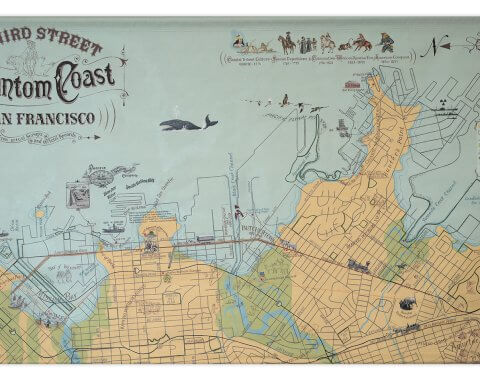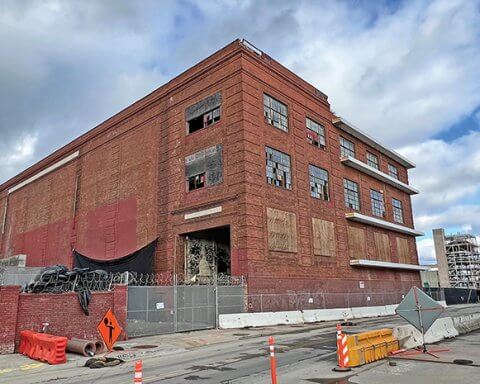In June, the San Francisco Municipal Transportation Agency (SFMTA) released a revised proposal for a 17th Street Quick-Build Project, which’d rely on non-permanent materials, thereby shortening construction times and cutting costs. The new plan calls for a protected bike lane, buffered from the roadway by offset parking paths from the curb known as “floating parking”, with plastic bollards and painted raised elements.
The push to establish a protected bicycle lane is largely the result of advocacy efforts by Safer17th, a three-year-old group founded by Potrero Hill residents. The organization wants to protect the wellbeing of cyclists, particularly younger people. Safer17th has collected more than 700 signatures supporting its advocacy.
“One of the things that’s been great about this effort is the way it’s been driven by local residents. It’s made of people who use 17th Street in their daily lives advocating for how it can be improved,” said Peter Belden, a Vermont Street resident, parent of two high schoolers and Safer17th volunteer organizer. “I think we end up with better solutions because it’s very locally attuned.”
The 17th Street Quick-Build Project would stretch from Potrero Avenue to Mississippi Street, “a key connection in San Francisco’s bikeway network,” according to SFMTA. With 16th Street optimized for buses and cars, 17th Street is a main route for bike commuters traveling between the Eastern neighborhoods and the Mission, who reflect upwards of 40 percent of traffic along the project’s corridor.
“There are only so many ways to get places…because hills and highways are in the way. 17th Street is the best route for bikes, but that doesn’t mean it is a safe route. There is a lot of double parking with trucks,” said Kate Blumberg, a 22nd Street resident whose youngster, Benno, will attend Lowell High School this fall. “More and more people on the Hill bike places. I’ve been biking with my son everywhere, but for him to bike by himself, there needs to be infrastructure that we can count on to make sure that these kids can bike themselves places.”
Nearby businesses are concerned that the proposed lane-size reduction in curbside parking, as well as the loss of passenger and commercial loading zones, could prompt adverse economic impacts. The proposed design would eliminate 129 of 185 parking spots on 17th Street from Potrero Avenue to Mississippi Street. SFTMA estimates there are 1,800 on-street parking spaces within a one-block radius of 17th Street, typically used by people with close by destinations.
The plan attempts to keep street parking outside businesses where possible while retaining existing passenger and commercial loading zones by shifting the floating parking lane from one side of the street to another on different blocks. This wiggle has the additional benefit of traffic calming, as straight roads encourage drivers to travel at higher speeds.
The white loading zone is slated to remain outside Bottom of the Hill, albeit slightly shorter, with one parking lane remaining on the same side of the street as the venue. Existing zones that’d be replaced by the bike lane would be moved to adjacent streets.
“The neighborhood around us has changed a lot in the last 15 years, so the infrastructure no longer works. We’re having growing pains in terms of figuring out how to make it work better,” said J.R. Eppler, a Connecticut Street resident and Potrero Boosters Neighborhood Association president, with a son, Frank, at Daniel Webster Elementary School. “The usage of this corridor for bicycle traffic is only going to increase, so taking the opportunity now to make it work better — not just for the bicycles but for the cars that have to mix with the bicycles — makes sense. We’ve worked with businesses to try to optimize what parking would remain.”
Short-term green parking and metered zones outside businesses could help offset decreased parking along the corridor by accelerating parking turnover. Additionally, the neighborhood will gain more than 150 off-street parking spots associated with opening of the San Francisco Flower Market on the corridor’s eastern side, which’ll be available for public use after regular business hours.
“The lower part of Potrero Hill has never had well-regulated parking, and as a result, it becomes a parking lot for people who go to their destination outside of the area,” Eppler said. “I think that enhancing targeted parking controls for the local businesses will help mitigate any impacts from the removal of parking spaces along the route. I would like to see that as part of the final plan.”
“I think they’ve done a smart job of preserving the white loading zone, shuttle zone; they’ve added some commercial loading zones. So overall, it’s a great design but there are always little tweaks where it can be better,” Belden commented. “The intersection of Potrero Avenue needs more protection, but overall, I think the proposal is something that will be a real step forward.”
“This is a great way to serve the neighborhood. It opens up the City for our residents in our neighborhood and so I think it’s a big win for making the whole City more accessible,” Jessica Holmes, a cyclist and PREFund board member, said.
PREFund is a nonprofit that works to ensure Potrero Hill families have access to quality educational opportunities.
“This opportunity at lower cost, using paint on the roadway and plastic bollards, is a good way to see how this protected bike lane will work and provide the blueprint for a more permanent protected facility in the future,” Eppler said.
While the protected bike lane is the focus of the Quick-Build project, other traffic safety improvements are included in the plan. A stop sign on 17th Street would be added at the Carolina Street intersection. Presently, a lack of traffic controls along 17th adjacent to Jackson Park enables vehicles to travel at faster speeds. The City’s new “crossbikes” — continental crosswalk striping extended into the street painted green – would be added to increase bike lane visibility.
“One thing that doesn’t get talked about is the way the quick-build will also make crossings much safer for pedestrians,” Belden said. “Right now, if you walk across 17th Street, you’ve got six feet of bike lane, 22 feet of cars, and another six feet of bike lane. That’s over 30 feet to cross, and when you have over 30 feet of unobstructed space, people tend to drive faster.”
The protected bike lane narrows the roadway width to roughly 20 feet, which’d further slow traffic.
“Walking those 20 feet for pedestrians makes it significantly safer, especially people who walk slower, older people, and those with disabilities. People have a refuge before they get to the sidewalk,” Belden said.
Four additional striped crosswalks would be added along 17th Street at Texas, Missouri, Connecticut, and Wisconsin streets to help increase pedestrian visibility. Black and yellow painted raised elements would be placed in the roadway of some intersection corners to create extra space from traffic, serving to safeguard bike lane users and pedestrians crossing the street.
“It’s not the worst street. Seventeenth is one of those streets where you see bikes because it’s a decent street, but it could be so much better. With this proposal, it will be so much better,” Blumberg emphasized.
“This project is more than just protected bike lanes; it’ll make things safer for a range of folks,” Belden concluded.
SFMTA plans to approve a final design in time to implement the project this fall.



